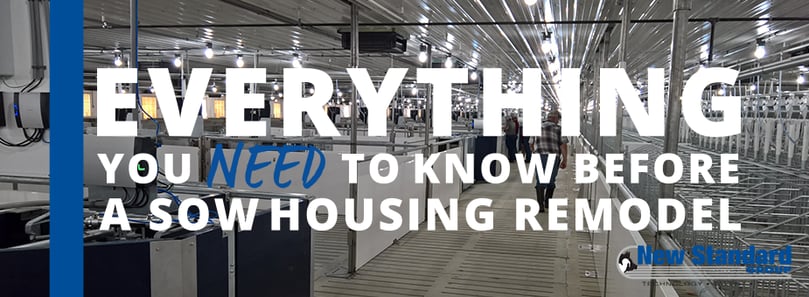
Making the decision to remodel your existing sow housing barn may seem daunting. You will have to restructure your barn, buy new equipment, and train your pigs and barn staff on the new processes. We promise that making this decision is worth your time and investment, but we understand effort this transition takes. That is why we want to provide you with everything you need to know about a sow housing remodel before you make the decision.
Preparing for Your Sow Housing Remodel
When preparing for a sow housing remodel, planning ahead is key. It is essential that all equipment, parts, tradespeople, and other major pieces of the building are decided on and arranged to be available before contruction begins. This includes doing a full review of the entire area that will be converted and deciding if any other changes or upgrades will be made while the barn is being renovated. These changes may include ventilation and lighting upgrades or even deciding whether or not to paint while the barn is empty. Planning ahead will ensure that the project will progress smoothly without any major delays.
The biggest factor that we have to consider is where we will put the animals while the conversion is taking place. There are a few options available. If possible, an alternate barn (rental or another available facility) is the perfect place to house the sows during your barn conversion. If one of these facilities is not available, it is possible to downsize the herd in order to open up some space in the barn for crews to work in. This does have the advantage of allowing the farmer to cull the older animals, who tend to be harder to train. Of course the disadvantage here is the loss of production during and after the conversion. Whether you use an alternate facility or downsize will be dependent on the size, location, and health status of the herd.
Converting Your Sow Barn
One of the major concerns we hear before a sow housing remodel is that farmers will have to lose space and inventory in order to accommodate the new equipment and design. However, the reality is that it is often possible to convert to a loose housing barn without losing any animal spaces or inventory. In a worst case scenario, the herd would shrink by 5-10%, but your actual production will remain unchanged or increase as sows in a proper loose housing barn will have more piglets than the same sows in a stall barn.
It may comfort you to know the existing floor layout, even in partially slatted sow barns, will be able to be used in a loose housing barn. Typically, only a minimal amount of pit work needs to be done to achieve the desired floor plan. Depending on the style and condition of the slats that are in place, they may not have to be touched or they may need to be changed completely during the conversion. Since having the proper slats in place becomes very important when you house sows in groups (avoiding foot and leg issues), this is not an item that can be overlooked. Due to the varying styles of slats, what you have to do can only be determined after analysis of what is currrently in place.
If everything is planned properly, the conversion can be completed within 5-6 weeks. This is the case for any phase or room; the size does not typically change the timeframe. This is due to the progression of the work that needs to be done, and the required sequential steps. (ie. waiting for concrete to cure before progressing further)
Training the Animals and Barn Staff
The training of the animals and your barn staff is the final and one of the most important steps. The success of your loose housing barn depends on how well your staff and animals have been trained and are continuously supported. Well-educated and trained employees will make your newly renovated barn operations run smoothly and efficiently. The pigs will be trained using training pens where their natural curiousity will allow them to become comfortable with the new equipment. Learn more about this training process here. The training can usually be accomplished during the barn remodel, but each barn needs to have a plan in place for this to happen. This training will take a few weeks, but in the end, your loose housing barn will bring comfort to your pigs and efficiency to your processes, which will lead to higher production and profits.
If you are considering a sow housing remodel, we would love to have a conversation with you. We will sit down and talk about your needs in your facilities to find the right solutions for you. If you would like to start this conversation, give us a call or click the button below.





